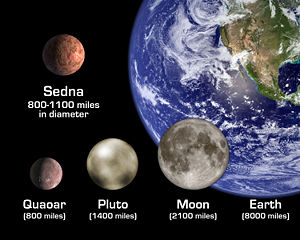 Image via WikipediaFour years ago today, the International Astronomical Union voted to revise the current IAU definition of a planet -- adopting the one that didn't include Pluto. This, of course, led to some blowback in the astronomy community (and the sci-fi/internet community, too). Team Pluto, however, didn't have much in the way of empirical evidence to back the position Pluto deserved to stay -- especially since it wasn't even the largest member of the newly minted dwarf planet group to which it now belongs.
Image via WikipediaFour years ago today, the International Astronomical Union voted to revise the current IAU definition of a planet -- adopting the one that didn't include Pluto. This, of course, led to some blowback in the astronomy community (and the sci-fi/internet community, too). Team Pluto, however, didn't have much in the way of empirical evidence to back the position Pluto deserved to stay -- especially since it wasn't even the largest member of the newly minted dwarf planet group to which it now belongs.How many dwarf planets are bigger than Pluto?
Actually, there's just one dwarf planet larger than Pluto: Eris, which is about 25 percent more massive than Pluto itself. Heck, discounting the sun and the eight actual planets, there are eight other objects in the solar system more massive than Pluto. Jupiter has four moons more massive than Pluto; Earth's moon is bigger, too.
The number of super-Pluto dwarf planets could also grow, given the long list of dwarf planet candidates with indeterminate diameters or masses. The Spitzer Space telescope finds more all the time (or, rather, it's giving us better data on known objects, which astronomy post-grads can pore through over the next decade or three). Right now there's nothing out there in the Pluto-Eris class, but the Oort Cloud is notorious for its obscure surprises, so it's far from unlikely that Pluto may get demoted again -- earning the dwarf planet another footnote in the Truly Trivial.
